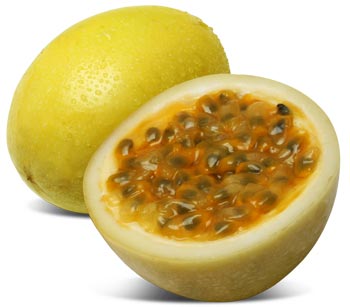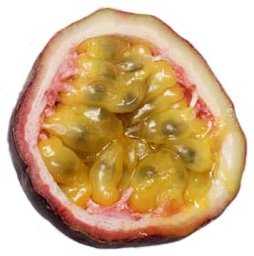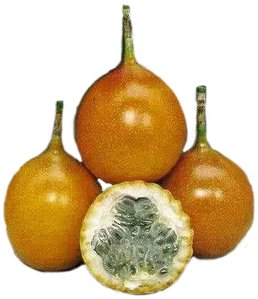

Passion Fruit

Passiflora. (From Latin passio, passion and flos, flower, hence ‘passion flower’. The name was given by the early Spanish missionaries in South America, in reference to a fancied representation in the flowers of the implements of the Crucifixtion; the corona represented the crown of thorns, the five anthers the five wounds, the three styles the three nails, the five sepals and five petals the apostles, less Peter and Judas, and the hand-like leaves and flagellate tendrils the hands and scourges of Christ’s persecutors.) PASSION FLOWER. Passifloraceae. Some 500 species of vines or scandent shrubs, sometimes erect herbs, shrubs or small trees. Shoots often angular, furnished with long, tightly spiralling tendrils arising at axils. Leaves alternate, extremely variable in shape, usually 3-5-lobed, sometimes bilobed or entire; petioles often with stalked glands. Flowers regular, bisexual, usually solitary, sometimes paired and axillary or in very short terminal cymes, usually subtended by three green bracts; calyx cupped to tubular, sepals 5, fleshy or membranous; petals 5, sometimes absent; filaments in several series, forming a showy corona between petals and stamens; stamens 5 on a gyophore, anthers linear, ovate or oblong, 2-celled; stigma capitate; styles 3; ovary globose, ovoid or fusiform. Fruit usually a juicy, indehiscent, many-seeded berry; seeds compressed, reticulate, puncticulate or transversely furrowed. Tropical Americas, Asia, Australia, Polynesia. CultivationGrown as ornamentals for their exquisitely beautiful, intricately formed and often fragrant and nectar-rich flowers, and for their attractive, sometimes edible fruits; a number are grown commercially for their fruits in the subtropics and in tropical highlands. The fruits of many species are eaten raw, or in some cases used to prepare drinks, ice cream, pies, sauces and so on; some are canned in syrup or candied. Passiflora ligularis is considered by many to be the best edible species, while Passiflora alata, Passiflora laurifolia, Passiflora mollissima and Passiflora quadrangularis are also widely cultivated for fruit. Few species are sufficiently cold tolerant for outdoor cultivation in cool temperate zones. They include the more or less evergreen Passiflora caerulea, which with some protection of a sheltered wall will survive occasional lows down to -15ºC; in cooler conditions it may be regarded as a herbaceous perennial since with sufficient protection at the root it will resprout from the base in spring. Passiflora incarnata, with a truly herbaceous habit, will resprout from the base if given deep mulch protection where temperatures fall to -20ºC. Passiflora lutea, also herbaceous, is the hardiest species, occurring as far north as Pennsylvania, and surviving given similar treatment, temperatures as low as -25ºC. They are fairly undemanding in their soil requirements, thriving in any moderately fertile, well-drained and adequately moisture-retentive soil, in sun or part-day shade. Provide the support of wire or trellis and, in less favoured areas, site with shelter from cold, drying winds, mulch with leadmould, bracken litter and a covering of evergreen branches, protecting top-growth with burlap or hessian if necessary. The remaining species need protected cultivation in cool temperate zones, making uniquely handsome and, under suitable conditions, productive specimens for the glasshouse or conservatory. Passiflora edulis, Passiflora X allardii, Passiflora antioquiensis, Passiflora caerulea-racemosa, Passiflora X exoniensis, Passiflora ligularis, Passiflora manicata and Passiflora mollissima will tolerate winter temperatures as low as 5ºC, although they may defoliate in such conditions, and are better maintained at a temperature of around 7-10ºC. Most of the remaining species require a temperature range of 13-16ºC. When grown for fruit, warm conditions are necessary; around 16ºC during flowering to ensure good fruit pollination and fruit set, temperatures thereafter being less critical. hand pollination using unrelated clones, or Passiflora caerulea, and spraying with tomato setting hormone for seedless fruit, helps ensure good fruiting; Passiflora quadrangularis is self sterile, and in Passiflora edulis pollen is usually shed before the pistils are receptive. Passiflora coccinea and Passiflora vitifolia, amongst the most handsome of ornamentals, are also self sterile but will fruit if hand-pollinated. 
Grow all species in a freely draining, fibrous loam-based mix with additional leafmould and sharp sand; Passiflora species are generally unfastidious as to soil type, given good drainage, but perform best on soils of only moderate fertility, especially with regard to nitrogen, which encourages foliar growth at the expence of flowering. They are best grown in large pots or tubs, or if grown in the open border, with some root restriction. provide full sun with shade from the hottest sun in summer, water plentifully when in growth, sparingly at other times. Prune to prevent overcrowding by removing the weakest shoots in spring, an again if necessary after flowering, pinching out unwanted growth regularly during the growing season; spur back to an established framework in spring. Propagate by heel or nodal cuttings rooted in individual pots in a sandy propagating medium in a closed case or by seed. Evidence suggests that a number of frost-tender species show greater tolerance of low soil temperatures when grafted on to Passiflora caerulea, and it may be a worthwhile experiment to grow and fruit Passifora edulis, for example, on Passifora caerulea rootstock in more favoured temperate gardens. Provide a warm south-facing or southwest-facing wall and train as a single-stemmed specimen on support low enough to allow winter protection with straw and burlap/hessian or frame lights. For the purposes of clarity only the more popular species grown for their fruits are featured below. Passiflora alataStems vining, stout, glabrous, with 4 winged angles. Leaves to 15 x 10cm, simple, ovate or ovate-oblong, apex acuminate, base rounded to subcuneate, entire or denticulate, membranous, glabrous, penninerved; stipules to 2 x 1cm, linear to ovate-lanceolate, entire or serrulate; petioles to 5cm, canaliculate, 2-4-glandular. Flowers to 12cm diameter, fragrant; pedicels to 2.5cm; sepals oblong, obtuse, glabrous green to white beneath, pale crimson above; petals oblong, obtuse brilliant carmine; filaments 4-seriate to 3cm, banded purple red and white. Fruit to 10 x 6cm, obovoid or pyriform, glabrous, yellow. Spring-summmer. NE Peru, E Brasil. ‘Ruby Glow’: fruit yellow, grapefruit-sized. Z10. Passiflora edulisGRANADILLA; PURPLE GRANADILLA; PASSION FRUIT. Stems vining, bluntly angled, somewhat languinose or glabrous. Leaves to 10 x 20cm, deeply trilobed, lobed ovate, glandular-dentate, shiny above, glabrous; petioles biglandular. Flowers to 7.5cm diameter; bract 12.5mm or more; sepals oblong, spreading, white above, green beneath; petals somewhat narrower and paler than sepals; filaments white banded purple or indigo, strongly wavy towards tips. Fruit 5cm diameter, ovoid, green-yellow to dull purple, speckled. Summer. Brasil. forma edulis. Fruit yellow. ‘Alice’: flowers abundant; fruit egg-shaped, purple. ‘Crackerjack’: fruit large, deep purple to black, abundant. ‘Purple Passion’: flowers purple. ‘Supreme’: fruit large, rounded. Additional purple-fruited cultivars include ‘Black Knight’, ‘Edgehill’, ‘Frederick’, ‘Purple Giant’, ‘Red Giant’, ‘Red Rover’ and ‘Sunnypash’ (usually grafted on Passilflora caerulea; very adaptable). forma flavicarpa. Yellow-fruited cultivars include ‘Brazilian Golden’ and ‘Golden Giant’. Z10. Passiflora laurifoliaYELLOW GRANADILLA; WATER LEMON; JAMAICA HONEYSUCKLE; BELLE APPLE; VINEGAR PEAR; POMME-DE-LIANE. Stems vining, cylindric, glabrous. Leaves to 12 x 8cm, ovate-oblong to oblong, subacute to obtuse, apex usually mucronate, base rounded, entire, coriaceous, glossy, glabrous, strongly reticulately 1-veined; stipules to 4mm, narrow-linear, coriaceous; petioles to 1.5cm, stout, biglandular. Flowers to 7cm diameter; pedicels to 3cm, rarely to 8cm; calyx to 1cm, cylindric-campanulate, glabrous,sepals to 2.5 x 1cm, green beneath, red above, oblong, obtuse; petals similar to sepals; filaments 6-seriate, outermost purple banded red, blue and white. Fruit to 8 x 4cm, ovoid, glabrous, lemon-yellow or orange; seeds to 7 x 5mm, obcordate, finely reticulate. Summer. E Brasil, Peru, Venezuela, Guianas, W Indies, Trinidad. Z10. Passiflora ligularis
GRANADILLA; SWEET GRANADILLA. Stems vining, vigorous, cylindric, glabrous. Leaves to 15 x 13cm, broadly ovate, apex abruptly acuminate, base deeply cordate, entire, membranous, glabrous, blue-green beneath, penninerved; stipules to 2.5 x 1.2cm, lanceolate; petioles to 10cm, 4-6-glandular, with filiform glands. Flowers to 9cm diameter, pedicels to 4cm; calyx campanulate, glabrous, sepals to 3.5 x 1.5cm, green-white beneath, white or rosy above, ovate-oblong, acute; petals similar to sepals but smaller; filaments 5-7-seriate, white banded, purple, the outer series equalling the petals. Fruit to 8 x 5cm, ovoid, glabrous; seeds 6 x 4mm, narrow-obcordate, tridenticulate at apex, irregularly reticulate. Autmun. C Mexico, C America, Venezuela, Peru, W Bolivia. Z10. Passiflora mollissimaCURUBA; BANANA PASSION FRUIT. Stems vining, cylindric, striate, with soft golden pubescence. Leaves to 10 x 12cm, trilobed, lobes ovate, apex acute, base subcordate, sharply serrate-dentate, soft-pubescent above, tomentose beneath, membranous; stipules to 9 x 4mm, subreniform; petioles to 3cm. Flowers pendulous; pedicels to 6cm; calyx to 8 x 1cm, olive-green, glabrous, long-tubular, sepals to 3.5 x 1.5cm, soft pink, oblong, obtuse; petals obtuse, same colour as sepals; corona reduced to a warty rim. Fruit to 7 x 3.5cm, oblong-ovoid, yellow-soft pubescent; seeds to 6 x 5mm, broad-obovate, reticulate. W Venezuela, Colombia, SE Peru, W Bolivia. Z6. Passiflora quadrangularisGRANADILLA; GIANT GRANADILLA. Stems vining, stout, 4-angular, angles distinctly alate, glabrous. Leaves to 20 x 15cm, ovate-lanceolate, apex abruptly acuminate, base rounded to cordate, entire, glabrous, penninerved; stipules to 3.5 x 2cm, ovate, acute; petioles to 5cm, stout, 6-glandular. Flowers to 12cm diameter; pedicels to 3cm; calyx shallowly campanulate, glabrous, sepals to 4 x 2.5cm, green beneath, pearly grey-green tinted flesh pink above, ovate or ovate-oblong, concave; petals to 4.5 x 2cm, fleshy, pale mauve-pink, oblong-ovate to oblong-lanceolate, obtuse; filaments 5-seriate, white, banded blue and red-purple, equalling sepals and strongly twisted. Fruit to 30 x 15cm, oblong-ovoid, glabrous; seeds to 10 x 8.5mm, broad-obcordate or suborbicular, reticulate. Tropical America. ‘Variegata’: leaves splotched yellow. Z10.
|
Home
Grow Herbs
Grow Nuts
Grow Vegetables
Cyberian Index
If you like this website and want one of your own contact
Cyberian All information correct at
time of publication and open to updates as necessary. No part of this website,
or its vectors, may be produced in any shape or form, using any type or design
of medium, system, equipment or otherwise without the prior written consensual
notice of the Cyberian. Any breach of these requirements will result in the
appropriate action. If in doubt, e-mail contact is recommended.
Some components of this website were obtained as open-source software and are
used in the same non-profit manner on this website.